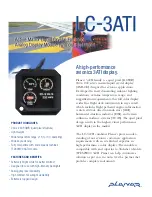
I
NSTALLATION
MOVING CASES
Hill PHOENIX display cases are generally shipped to stores
with casters installed on the base frame. The casters make the
job of moving cases easier for everyone involved in the ship-
ping and installation process, as well as reducing the chance of
damage from raising and lowering cases with ”J” bars to place
them on dollies, skates or rollers. In most situations, one or two
persons can easily move the case into position.
When the cases arrive at the store, simply roll them on to the
store
fl
oor to the proper staging area. Occasionally, cases are
shipped with skid boards attached to help with stabilization. In
these instances, the casters should be attached after the case is
removed from the truck.
Removing the casters is an easy process. Simply
fl
atten and
remove the cotter pins that are holding the casters in place (see
Fig. 1). Then lift the case with a “J” bar and slide the caster
assemblies out. The dismantled casters can now be discarded.
W A R N I N G
▲
Be certain that your hands and feet are out of the way
before lowering the case after the removal of the cast-
ers. Failure to do so may result in serious injury.
FLOOR PREP
1.
Ask the general contractor if there have been changes in
the building dimensions since the print you are using was
issued. Also, ask for the points of reference from which
you should take dimensions to locate the cases.
2.
Using chalk lines or a laser transit, mark the
fl
oor where
the cases are to be located for the entire lineup. The lines
should coincide with the outside edges of the base frame.
3.
Leveling is necessary to ensure proper case alignment and
to avoid potential damage. Locate the highest point on the
positioning line as a reference for determining the proper
height of the shim-pack levelers. A laser transit is recom-
mended for precision and requires just one person.
4.
Locate the position of the base frame and spot properly lev-
eled shim packs at the appropriate locations.
LINE-UP & INSTALLATION
1.
Remove anything from the cases that may interfere with
case joining (eg. shipping braces).
2.
Roll the
fi
rst case into position. Using a “J” bar , raise the
end of the case (under cross support), remove the casters,
and place the base frame on the shim packs. Repeat on the
other end of the case.
3.
Once the base frame is properly placed on the shim packs,
check the vertical level by placing a bubble level plumb to
the rear edge of the case; then add/remove shim levels as
needed. To check the horizontal level, repeat this process
after placing the bubble level on the rear sill.
TRIM OUT
Attach the front kick plate to the retainer using the screws
provided. To attach the end kick plates, slide them under the
case ends, thread the hanging connector tabs into the provided
slots, then drop the kick plates down into place (see Fig. 2).
Fig. 1 Cotter pin attaches the caster
to the case
COTTER PIN
CONNECTOR
TAB
SLOT
FRONT
KICK PLATE
SCREW
Fig. 2 Attaching the front and end kick plates
5
Содержание OWZA
Страница 2: ...ii ...
Страница 15: ...APPENDIX A DOMESTIC WIRING DIAGRAM ...
Страница 16: ......
Страница 17: ......
Страница 18: ......
Страница 19: ......
Страница 20: ...APPENDIX B EXPORT WIRING DIAGRAM ...
Страница 21: ......
Страница 22: ......
Страница 23: ......
Страница 24: ......
Страница 25: ...APPENDIX C CONTROLLER INFORMATION ...
Страница 29: ...APPENDIX D USER SET POINTS ...
Страница 30: ......
























